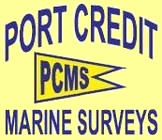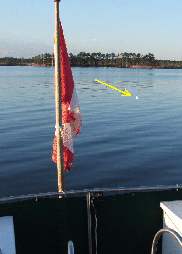 Port Credit Marine Survey & Yacht Delivery |
6. Ground Tackle & How to Use it. |
 Port Credit Marine Survey & Yacht Delivery |
6. Ground Tackle & How to Use it. |
| The first time we cruised the Hudson River
we ended up in marinas and on mooring
balls
because the river seemed so open. Many
years
and many trips on the Hudson later
we have
found dozens of snug little holes to
drop
the hook. It takes time and experience
but
you will get comfortable anchoring
as your
knowledge base expands. |
|
|
Few topics in boating will generate more
arguments than this so for what it’s
worth
here are my own highly prejudiced opinions.
Successfully launching and retrieving
ground
tackle, while not rocket science, is
not
as simple as it appears what with currents, rough water, blinding spray or
poor light. |
 Isle of Skye ground tackle arrangement with snubber running out starboard hawsepipe and the all important washdown hose to port. |
| Many production boats have poorly designed
bow rollers that don’t have room for two anchors or they may not be designed for your choice
of anchor and likely didn’t come with a chain
hook or rode cleat. In the photo above
right
- You can just make out the 5"X5"
sampson post with stainless steel bit
on
our stemhead. A real rode cleat is
much more
substantial than the chrome thing secured
with two ¼” bolts through balsa core
that
many boat builders provide. Two different type anchors should be kept at the bow as you will occasionally find that for some reason one type will not set. We also always have a Danforth ready to go at the stern. Over the years we have twice lost power going downstream in narrow cuts where dropping a bow anchor would have sent us ashore. We regularly anchor in narrow creeks (mostly in Georgia) where there is not enough room to swing so bow and stern anchors are the way to go. We have even anchored with bow and stern anchors ashore in Georgia. If you try this, check the depth with a boat pole as there is sometimes an underwater shelf that can hang you up when the tide drops. |
|
 In tandem - Two anchors off the bow with a caribiner from the near anchor on to the primary rode. |
 The Bahamian Moor can leave you hopelessly tangled after a few tidal 360's |
| The Anchor Float - Notice the current streaming by our anchor
float which is lying off our stern. With
the weight of the chain our anchor float
is often under or behind us depending on
wind and current. Some cruisers strenuouly
object to the use of floats but I need to
know where my anchor is all the time. I also
need to know where everyone else’s is. With
a float, determining your relative position
is easier and helps you envision your swing
circle. We have seen collisions where one
boat ran over a rode pulling both boats together
…. wouldn't have happened if a float had
been in place. On several occasions I have seen the tangled mess when one hook was dropped on top of another making two helplessly drifting boats. We use a milk jug and very light twin in case (it's never happened) it gets tangled in our propeller no damage would be done.. Imagine this scenario then decide if you want a float or not. A boat pulls in the anchorage and asks "How much rode do you have out ?" We respond " 120' in 7' of water" . So he anchors 100' aft. As the wind comes up we fall back 150' and collide. Think this can't happen ? Take alook at the photo at right that shows our float astern of the boat. |
|
 Anchor float astern in a tidal stream as the tide turns |
 Our anchor float 100' off our stern. |
| Pick Your Spot - I've already mentioned that we don't anchor
near boats with rope rodes, neither do we
anchor near catamarans as they react very
differently than monohulls in certain conditions.
We once witnessed a collision between a 50'
monohull and a 50' catamarran in the mooring
ball field (now gone) in Charleston. The
monhull was riding on the current and the
cat riding on the wind .... bang ! Photo below right taken at 8X zoom shows a 65’ steel trawler dragging a 65lb. CQR through Marsh Harbour in a gale with gusts to 48 knots. We are anchored 3/4 of a mile away from this mess near the harbour mouth. Carefully picking your spot can be a great stress |
|
| reliever. For convenience sake, setting the anchor close to your fellow cruisers,
the free dinghy dock or off a pretty beach
is nice however, winds change and what looked
great on a sunny afternoon may not be much
fun at 0500 when the wind comes calling.
Cruisers tend to congregate at one end of the harbour like Marsh harbour. We prefer to anchor well out of the crowd whenever possible even if it means being a little more exposed. I am willing to take responsibility for my own actions but reluctant to be a victim of others. Better a long dinghy ride than a sleepless night. When forced into a crowded anchorage be aware of the etiquette. Always anchor down stream or downwind of those already in position. Always anchor in the same style. Always ask your how much rode your neighbors have out and match it. If you don’t think he has enough out ... move. Don’t wind through everyone else to get closer to the dinghy dock and don’t anchor next to the Sea Ray with 8 guys drinking. |
 A tangle in Marsh Harbour as a 65' trawler drags through |
| Anchor Light - Always, always turn on your anchor light
even if only to help find your own boat after
the party. Day anchor signals (black ball) are a rarity in fact the only one I have ever seen is my own even though they are required by ColRegs. In one case in broad daylight seven boats in a designated anchorage were hit by a cruise boat that had lost steerage, only the one with a day anchor signal was compensated. The insurance company found the one exception to the use of anchor signals in the designated anchorage rule. The Bitter End - No, not your last divorce. Yet another ground tackle subject of controversy. Most secure the bitter end of the rode with clamps, shackles or some mechanical means but what happens when you have yo get out right now ! Do you have huge chain cutters at the ready ? Some advocate having the last 10’ of your chain secured with rope that you can easily cut if you have to escape in a hurry and some believe in not securing the bitter end at all. That anchor float will help you find your tackle later. Let me know if you turn up a 22lb. Danforth and 250' of 3/4" rode at Allens-Pensacola Key. The very nature of this missive leans towards the negative and Mama tol' you there'd be days like that. Did she also mentions the free lobsters in Dry Tortugas. 
|
 There are six idiots anchored between us and the bridge lights in the distance. |
 The joys of anchoring. That white wall coming towards us is a tornado marching down Pungo Creek. The 44lb. Bruce held !  Isn't she the prettiest thing you've ever
seen ? Isn't she the prettiest thing you've ever
seen ? |
|
Chapter 7. Mooring balls & Docks. Back to Index Need a marine surveyor in Ontario... See this list of Every Marine Surveyor in Ontario 
|
|